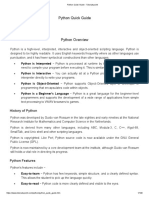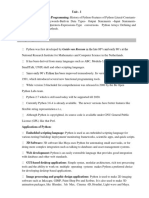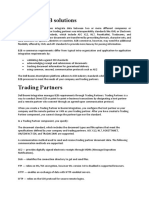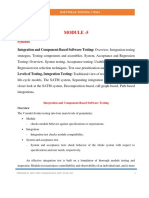Python Scripting
Uploaded by
Ravikumar TumuluriPython Scripting
Uploaded by
Ravikumar TumuluriPython is a general-purpose interpreted, interactive, object-oriented, and high-level
programming language. It was created by Guido van Rossum during 1985- 1990. Like Perl, Python
source code is also available under the GNU General Public License (GPL).
Python is a high-level, interpreted, interactive and object-oriented scripting language. Python is designed
to be highly readable. It uses English keywords frequently where as other languages use punctuation, and
it has fewer syntactical constructions than other languages.
Python is Interpreted − Python is processed at runtime by the interpreter. You do not
need to compile your program before executing it. This is similar to PERL and PHP.
Python is Interactive − You can actually sit at a Python prompt and interact with the
interpreter directly to write your programs.
Python is Object-Oriented − Python supports Object-Oriented style or technique of
programming that encapsulates code within objects.
Python is a Beginner's Language − Python is a great language for the beginner-level
programmers and supports the development of a wide range of applications from
simple text processing to WWW browsers to games.
Python Features
Python's features include −
Easy-to-learn − Python has few keywords, simple structure, and a clearly defined
syntax. This allows the student to pick up the language quickly.
Easy-to-read − Python code is more clearly defined and visible to the eyes.
Easy-to-maintain − Python's source code is fairly easy-to-maintain.
A broad standard library − Python's bulk of the library is very portable and cross-
platform compatible on UNIX, Windows, and Macintosh.
Interactive Mode − Python has support for an interactive mode which allows
interactive testing and debugging of snippets of code.
Portable − Python can run on a wide variety of hardware platforms and has the same
interface on all platforms.
Extendable − You can add low-level modules to the Python interpreter. These modules
enable programmers to add to or customize their tools to be more efficient.
Databases − Python provides interfaces to all major commercial databases.
GUI Programming − Python supports GUI applications that can be created and ported
to many system calls, libraries and windows systems, such as Windows MFC, Macintosh,
and the X Window system of Unix.
Scalable − Python provides a better structure and support for large programs than shell
scripting.
Python has a big list of good features, few are listed below −
It supports functional and structured programming methods as well as OOP.
It can be used as a scripting language or can be compiled to byte-code for building large
applications.
It provides very high-level dynamic data types and supports dynamic type checking.
IT supports automatic garbage collection.
It can be easily integrated with C, C++, COM, ActiveX, CORBA, and Java.
Python is available on a wide variety of platforms including Linux and Mac OS X. Let's understand how to
set up our Python environment.
You might also like
- Python Programming: Powered by Ganesh KavharNo ratings yetPython Programming: Powered by Ganesh Kavhar4 pages
- Employee Salary Management System Using PythonNo ratings yetEmployee Salary Management System Using Python3 pages
- Python Is Interpreted: Python Is Interactive: Python Is Object-Oriented: Python Is Beginner's LanguageNo ratings yetPython Is Interpreted: Python Is Interactive: Python Is Object-Oriented: Python Is Beginner's Language1 page
- Python Programming Unit - I: History of PythonNo ratings yetPython Programming Unit - I: History of Python18 pages
- Python - Tutorial: #!/usr/bin/python Print "Hello, Python!"No ratings yetPython - Tutorial: #!/usr/bin/python Print "Hello, Python!"174 pages
- 3 Introduction To Python: National Research Institute For Mathematics and Computer ScienceNo ratings yet3 Introduction To Python: National Research Institute For Mathematics and Computer Science48 pages
- Sthiradasa ConceptsandIllustrationsColorNo ratings yetSthiradasa ConceptsandIllustrationsColor19 pages
- Solution Brief Tibco Activespaces Use Cases Tcm8 18978No ratings yetSolution Brief Tibco Activespaces Use Cases Tcm8 1897813 pages
- Quality Management System Procedure: (Laboratory Name)No ratings yetQuality Management System Procedure: (Laboratory Name)3 pages
- Sewp Zg651 Software Architectures: Akumbhar@wilp - Bits-Pilani - Ac.inNo ratings yetSewp Zg651 Software Architectures: Akumbhar@wilp - Bits-Pilani - Ac.in40 pages
- PM - Chapter 5 - R1 Systems Development Cycle Middle & Later Stages 200413No ratings yetPM - Chapter 5 - R1 Systems Development Cycle Middle & Later Stages 20041320 pages
- Tracking and Predecting Students Performance With Machine Learning0% (1)Tracking and Predecting Students Performance With Machine Learning47 pages
- Introduction - Serenity BDD Users ManualNo ratings yetIntroduction - Serenity BDD Users Manual5 pages
- TOPIC 1.0 INTRODUCTORY TO PROGRAMMING - FarahNo ratings yetTOPIC 1.0 INTRODUCTORY TO PROGRAMMING - Farah92 pages
- SQL Server 2019 AlwaysOn: Supporting 24x7 Applications with Continuous Uptime 3rd Edition Peter A. Carter download pdf100% (1)SQL Server 2019 AlwaysOn: Supporting 24x7 Applications with Continuous Uptime 3rd Edition Peter A. Carter download pdf65 pages
- Software Design and Architecture: Week 3 A Case Study: Designing A Document Editor - LexiNo ratings yetSoftware Design and Architecture: Week 3 A Case Study: Designing A Document Editor - Lexi42 pages
- 4Hk1 6HK1 Engine Diagnostic and Drivability Student PDF (035 040) PDF100% (1)4Hk1 6HK1 Engine Diagnostic and Drivability Student PDF (035 040) PDF6 pages





























































































